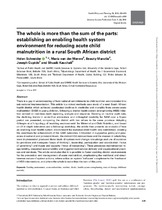| dc.contributor.author | Schneider, Helen | |
| dc.contributor.author | van der Merwe, Maria | |
| dc.contributor.author | Marutla, Beauty | |
| dc.contributor.author | Cupido, Joseph | |
| dc.contributor.author | Kauchali, Shuaib | |
| dc.date.accessioned | 2020-03-09T11:23:24Z | |
| dc.date.available | 2020-03-09T11:23:24Z | |
| dc.date.issued | 2019 | |
| dc.identifier.citation | Schneider, H., Van Der Merwe, M., Marutla, B., Cupido, J., & Kauchali, S. (2019). The whole is more than the sum of the parts: Establishing an enabling health system environment for reducing acute child malnutrition in a rural south african district. Health Policy and Planning, 34(6), 430-439. doi:10.1093/heapol/czz060 | en_US |
| dc.identifier.issn | DOI: 10.1093/heapol/czz060 | |
| dc.identifier.uri | http://hdl.handle.net/10566/5203 | |
| dc.description.abstract | There is a gap in understanding of how national commitments to child nutrition are translated into sub-national implementation. This article is a mixed methods case study of a rural South African health district which achieved accelerated declines in morbidity and mortality from severe acute malnutrition (SAM) in young children, following a district health system strengthening (HSS) initiative centred on real-Time death reporting, analysis and response. Drawing on routine audit data, the declining trends in under-five admissions and in-hospital mortality for SAM over a 5-year period are presented, comparing the district with two others in the same province. Adapting Gillespie et al.'s typology of 'enabling environments' for Maternal and Child Nutrition, and based on 41 in-depth interviews and a follow-up workshop, the article then presents an analysis of how an enabling local health system environment for maternal-child health was established, creating the conditions for achievement of the SAM outcomes. Embedded in supportive policy and processes at national and provincial levels, the district HSS interventions and the manner in which they were implemented produced three kinds of system-level change: knowledge and use of evidence by providers and managers ('ways of thinking'), leadership, participation and coordination ('ways of governing') and inputs and capacity ('ways of resourcing'). These processes mainstreamed responsibility, deepened accountability and triggered new service delivery and organizational practices and mindsets. The article concludes that it is possible to foster enabling district environments for the prevention and management of acute malnutrition, emphasizing the multilevel and simultaneous nature of system actions, where action on system 'software' complements the 'hardware' of HSS interventions, and where the whole is more than the sum of the parts. | en_US |
| dc.language.iso | en | en_US |
| dc.publisher | Health Policy and Planning | en_US |
| dc.subject | District | en_US |
| dc.subject | Nutrition | en_US |
| dc.subject | Enabling environment | en_US |
| dc.subject | Childhood mortality | en_US |
| dc.subject | Acute malnutrition | en_US |
| dc.title | The whole is more than the sum of the parts: establishing an enabling health system environment for reducing acute child malnutrition in a rural South African district | en_US |
| dc.type | Article | en_US |

